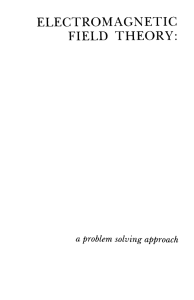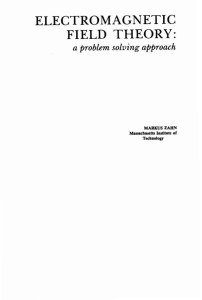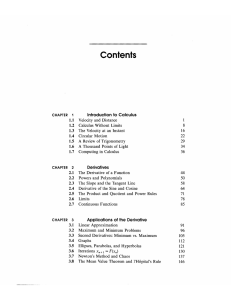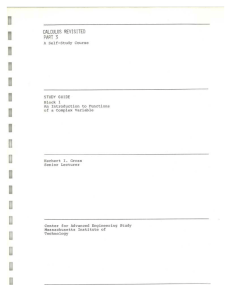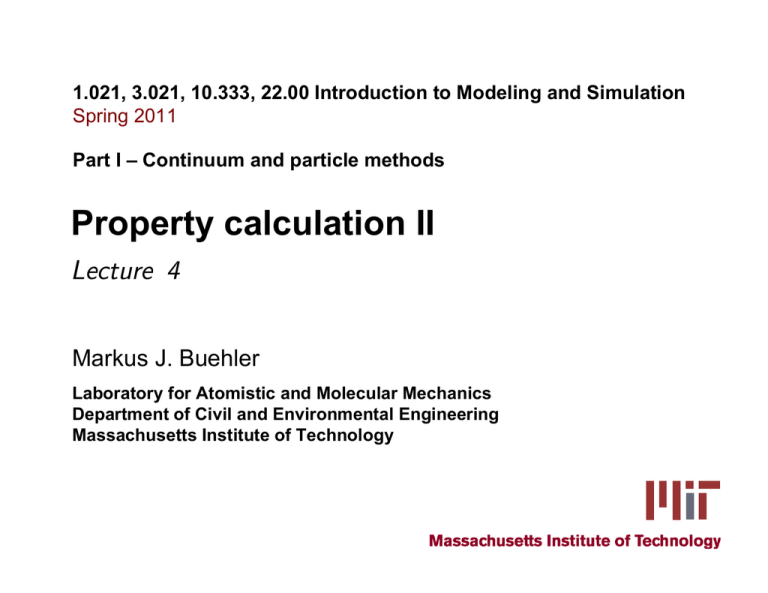
1.021, 3.021, 10.333, 22.00 Introduction to Modeling and Simulation
Spring 2011
Part I – Continuum and particle methods
Property calculation II
Lecture 4
Markus J. Buehler
Laboratory for Atomistic and Molecular Mechanics
Department of Civil and Environmental Engineering
Massachusetts Institute of Technology
1
Content overview
I. Particle and continuum methods
1.
2.
3.
4.
5.
6.
7.
8.
Atoms, molecules, chemistry
Continuum modeling approaches and solution approaches
Statistical mechanics
Molecular dynamics, Monte Carlo
Visualization and data analysis
Mechanical properties – application: how things fail (and
how to prevent it)
Multi-scale modeling paradigm
Biological systems (simulation in biophysics) – how
proteins work and how to model them
II. Quantum mechanical methods
1.
2.
3.
4.
5.
6.
7.
8.
Lectures 2-13
Lectures 14-26
It’s A Quantum World: The Theory of Quantum Mechanics
Quantum Mechanics: Practice Makes Perfect
The Many-Body Problem: From Many-Body to SingleParticle
Quantum modeling of materials
From Atoms to Solids
Basic properties of materials
Advanced properties of materials
What else can we do?
2
Overview: Material covered so far…
Lecture 1: Broad introduction to IM/S
Lecture 2: Introduction to atomistic and continuum
modeling (multi-scale modeling paradigm, difference
between continuum and atomistic approach, case study:
diffusion)
Lecture 3: Basic statistical mechanics – property
calculation I (property calculation: microscopic states
vs. macroscopic properties, ensembles, probability
density and partition function)
Lecture 4: Property calculation II (Advanced property
calculation, introduction to chemical interactions, Monte
Carlo methods)
3
Lecture 4: Property calculation II
Outline:
1. Advanced analysis methods: Radial distribution function (RDF)
2. Introduction: How to model chemical interactions
2.1 How to identify parameters in a Lennard-Jones potential
3. Monte-Carlo (MC) approach: Metropolis-Hastings algorithm
3.1 Application to integration
3.2 Metropolis-Hastings algorithm
Goal of today’s lecture:
-
Learn how to analyze structure of a material based on atomistic
simulation result (solid, liquid, gas, different crystal structure, etc.)
Introduction to potential or force field (Lennard-Jones)
Present details of MC algorithm – background and
implementation
4
1. Advanced analysis methods: Radial
distribution function (RDF)
5
Goals
Define algorithms that enable us to “make sense” of
positions, velocities etc. and time histories to relate
with experimentally measurable quantities
So far: temperature, MSD (mean square displacement
function)
Here: extend towards other properties
6
MD modeling of crystals – solid, liquid, gas phase
Crystals: Regular, ordered
structure
The corresponding particle
motions are small-amplitude
vibrations about the lattice site,
diffusive movements over a local
region, and long free flights
interrupted by a collision every
now and then.
Liquids: Particles follow Brownian
motion (collisions)
Gas: Very long free paths
Image by MIT OpenCourseWare. After J. A. Barker and D. Henderson.
7
Atomistic trajectory – through MSD
Courtesy of Sid Yip. Used with permission.
Need positions over time – what if not available?
8
How to characterize material state
(solid, liquid, gas)
Application: Simulate phase transformation (melting)
© Trivedi Chemistry. All rights reserved. This content is excluded from our Creative Commons license.
For more information, see http://ocw.mit.edu/fairuse.
http://www.t2i2edu.com/WebMovie/1Chap1_files/image002.jpg
9
How to characterize material state
(solid, liquid, gas)
Regular spacing
Irregular spacing
Neighboring
particles found at
characteristic
distances
Neighboring
particles found at
approximate
distances (smooth
variation)
More irregular
spacing
More random
distances, less
defined
© Trivedi Chemistry. All rights reserved. This content is excluded from our Creative Commons license.
For more information, see http://ocw.mit.edu/fairuse.
10
How to characterize material state
(solid, liquid, gas)
Regular spacing
Irregular spacing
Neighboring
particles found at
characteristic
distances
Neighboring
particles found at
approximate
distances (smooth
variation)
Concept:
More irregular
spacing
More random
distances, less
defined
© Trivedi Chemistry. All rights reserved. This content is excluded from our Creative Commons license.
For more information, see http://ocw.mit.edu/fairuse.
Measure distance of particles to their neighbors
Average over large number of particles
Average over time (MD) or iterations (MC)
11
Formal approach: Radial distribution
function (RDF)
Ratio of density of atoms at distance r (in control area dr) by
overall density = relative density of atoms as function of radius
g (r ) = ρ (r ) / ρ
Reference
atom
r
dr
12
Formal approach: Radial distribution
function (RDF)
The radial distribution function is defined as
Overall density of atoms (volume)
g (r ) = ρ (r ) / ρ
Local density
Provides information about the density of atoms at a given
radius r; ρ(r) is the local density of atoms
13
Formal approach: Radial distribution
function (RDF)
The radial distribution function is defined as
Overall density of atoms (volume)
g (r ) = ρ (r ) / ρ
Local density
Provides information about the density of atoms at a given
radius r; ρ(r) is the local density of atoms
Discrete:
Number of atoms in the interval r ±
Δr
2
< N ( r ± Δ2r ) > 1
g (r) =
Ω( r ± Δ2r ) ρ
Volume of this shell (dr)
g (r )2πr 2 dr = Number of particles that lie in a spherical shell
of radius r and thickness dr
14
Radial distribution function
Ω(r ± Δ2r ) considered volume
N (r ± Δ2r )
g (r ) =
Ω(r ± Δ2r ) ρ
Δr
2
Density
ρ = N /V
Note: RDF can be measured experimentally using x-ray or
neutron-scattering techniques
15
Radial distribution function:
Which one is solid / liquid?
© source unknown. All rights reserved. This content is excluded from our Creative
Commons license. For more information, see http://ocw.mit.edu/fairuse.
Interpretation: A peak indicates a particularly
favored separation distance for the neighbors to a given particle
Thus, RDF reveals details about the atomic structure of the
system being simulated
Java applet:
http://physchem.ox.ac.uk/~rkt/lectures/liqsolns/liquids.html
16
Radial distribution function
solid
liquid
© source unknown. All rights reserved. This content is excluded from our Creative
Commons license. For more information, see http://ocw.mit.edu/fairuse.
Interpretation: A peak indicates a particularly
favored separation distance for the neighbors to a given particle
Thus, RDF reveals details about the atomic structure of the
system being simulated
Java applet:
http://physchem.ox.ac.uk/~rkt/lectures/liqsolns/liquids.html
17
Radial distribution function:
JAVA applet
Java applet:
http://physchem.ox.ac.uk/~rkt/lectures/liqsolns/liquids.html
Image removed for copyright reasons.
Screenshot of the radial distribution function Java applet.
18
Radial distribution function:
Solid versus liquid versus gas
5
5
4
4
3
g(r)
g(r)
Solid Argon
2
Gaseous Ar
(90 K)
Liquid Ar
(90 K)
3
Gaseous Ar
(300 K)
2
Liquid Argon
1
0
1
0
0.2
0.4
distance/nm
0.6
0.8
0
0
0.2
0.4
0.6
0.8
distance/nm
Image by MIT OpenCourseWare.
Note: The first peak corresponds to the nearest
neighbor shell, the second peak to the second
nearest neighbor shell, etc.
In FCC: 12, 6, 24, and 12 in first four shells
19
Notes: Radial distribution function (RDF)
Pair correlation function (consider only pairs of atoms)
Provides structural information
Can provide information about dynamical change of
structure, but not about transport properties (how fast
atoms move)
20
Notes: Radial distribution function (RDF)
Pair correlation function (consider only pairs of atoms)
Provides structural information
Can provide information about dynamical change of
structure, but not about transport properties (how fast
atoms move)
Additional comments:
Describes how - on average - atoms in a system are
radially packed around each other
Particularly effective way of describing the structure of
disordered molecular systems (liquids)
In liquids there is continual movement of the atoms and
a single snapshot of the system shows only the
instantaneous disorder it is extremely useful to be able to
deal with the average structure
21
Example RDFs for several materials
22
RDF and crystal structure
1st nearest neighbor (NN)
3rd NN
2nd NN
…
Image by MIT OpenCourseWare.
Peaks in RDF characterize NN distance,
can infer from RDF about crystal structure
23
Face centered cubic (FCC), body centered
cubic (BCC)
Image from Wikimedia Commons, http://commons.wikimedia.org
Aluminum, NN: 2.863 Å
(a0=4.04 Å)
Chromium, NN:
2.498 Å (a0=2.91 Å)
Copper, NN: 2.556 Å
(a0=3.615 Å) )
Iron, NN: 2.482 Å
(a0=2.86 Å)
24
See also: http://www.webelements.com/
Hexagonal closed packed (HCP)
a
a
a
c
Image by MIT OpenCourseWare.
Image by MIT OpenCourseWare.
Image courtesy of the U.S. Navy.
Cobalt
a: 250.71 pm
b: 250.71 pm
c: 406.95 pm
α: 90.000°
β: 90.000°
γ: 120.000°
NN: 2.506 Å
Zinc
a: 266.49 pm
b: 266.49 pm
c: 494.68 pm
α: 90.000°
β: 90.000°
γ: 120.000°
NN: 2.665 Å
25
Graphene/carbon nanotubes
RDF
Images removed due to copyright restrictions.
Please see: http://weblogs3.nrc.nl/techno/wpcontent/uploads/080424_Grafeen/Graphene_xyz.jpg
http://depts.washington.edu/polylab/images/cn1.jpg
Graphene/carbon nanotubes (rolled up graphene)
NN: 1.42 Å, second NN 2.46 Å …
26
Macroscale view of water
Iceberg
Glacier
Image courtesy of dnkemontoh.
27
Image courtesy of blmiers2.
RDF of water (H2O)
Courtesy of Mark Tuckerman. Used with permission.
http://www.nyu.edu/classes/tuckerman/stat.mech/lectures/lecture_8/node1.html
28
RDF of water (H2O)
O-O distance
H-O distance
Images courtesy of Mark Tuckerman. Used with permission.
http://www.nyu.edu/classes/tuckerman/stat.mech/lectures/lecture_8/node1.html
29
RDF of water (H2O)
O-O distance
H-bonding
(≈2.8 Å)
H-O distance
H-O covalent bonding
(≈1 Å)
Images courtesy of Mark Tuckerman. Used with permission.
http://www.nyu.edu/classes/tuckerman/stat.mech/lectures/lecture_8/node1.html
30
2. Introduction: How to model chemical
interactions
31
Molecular dynamics: A “bold” idea
ri (t0 + Δt ) = −ri (t0 − Δt ) + 2ri (t0 )Δt + ai (t0 )(Δt ) + ...
2
Positions
at t0-Δt
Positions
at t0
Accelerations
at t0
ai = f i / m
Forces between atoms… how to obtain?
32
How are forces calculated?
Force magnitude: Derivative of potential energy with respect to
atomic distance
d U (r)
f =−
dr
To obtain force vector fi, take projections into the
three axial directions
x
fi = f i
r
r
x2
f
x1
Often: Assume pair-wise interaction between atoms
33
Atomic interactions – quantum perspective
How electrons from different atoms interact defines
nature of chemical bond
Density distribution of electrons around a H-H molecule
Image removed due to copyright restrictions. Please see the animation of
hydrogen bonding orbitals at
http://winter.group.shef.ac.uk/orbitron/MOs/H2/1s1s-sigma/index.html
Much more about it in part II
34
Concept: Interatomic potential
Energy U
r
1/r12 (or Exponential)
Repulsion
Radius r (Distance
between atoms)
e
Attraction
1/r6
Image by MIT OpenCourseWare.
“point particle” representation
Attraction: Formation of chemical bond by sharing of electrons
Repulsion: Pauli exclusion (too many electrons in small volume)
35
Interatomic bond - model
φ
Energy U
r
12
1/r (or Exponential)
Repulsion
Radius r (Distance
between atoms)
e
Attraction
r0
Harmonic oscillator
~ k(r - r0)2
r
1/r6
Image by MIT OpenCourseWare.
Image by MIT OpenCourseWare.
Attraction: Formation of chemical bond by sharing of electrons
Repulsion: Pauli exclusion (too many electrons in small volume)
36
Atomic interactions – different types of chemical bonds
Primary bonds (“strong”)
Ionic (ceramics, quartz, feldspar - rocks)
Covalent (silicon)
Metallic (copper, nickel, gold, silver)
(high melting point, 1000-5,000K)
Secondary bonds (“weak”)
Van der Waals (wax, low melting point)
Hydrogen bonds (proteins, spider silk)
(melting point 100-500K)
Ionic: Non-directional (point charges interacting)
Covalent: Directional (bond angles, torsions matter)
Metallic: Non-directional (electron gas concept)
Difference of material properties originates from different atomic
interactions
37
Interatomic pair potentials: examples
φ ( rij ) = D exp(− 2α ( rij − r0 ) ) − 2 D exp(− α ( rij − r0 ) )
⎡⎛ σ ⎞12 ⎛ σ ⎞6 ⎤
φ ( rij ) = 4ε ⎢⎜⎜ ⎟⎟ − ⎜⎜ ⎟⎟ ⎥
rij ⎠ ⎥
⎢⎝ rij ⎠
⎝
⎦
⎣
⎛σ ⎞
⎛ rij ⎞
φ ( rij ) = A exp⎜⎜ − ⎟⎟ − C ⎜⎜ ⎟⎟
⎝ σ⎠
⎝ rij ⎠
Morse potential
Lennard-Jones 12:6
potential
(excellent model for noble
Gases, Ar, Ne, Xe..)
6
Buckingham potential
Harmonic approximation
38
What is the difference between these
models?
Shape of potential (e.g. behavior at short or long distances,
around equilibrium)
Number of parameters (to fit)
Ability to describe bond breaking
39
Lennard-Jones potential
Parameters
ε ,σ
⎛ ⎡σ ⎤12 ⎡σ ⎤ 6 ⎞
φ (r ) = 4ε ⎜ ⎢ ⎥ − ⎢ ⎥ ⎟
⎜⎣ r ⎦
⎟
r
⎣
⎦
⎝
⎠
Lennard-Jones 12:6
Sir J. E. Lennard-Jones (Cambridge UK)
40
Lennard-Jones potential: schematic & parameter
meaning
φ
~σ
r
LJ 12:6
potential
ε : well depth (energy stored
per bond)
σ : proportional to point where
force vanishes (equilibrium
distance between atoms)
ε
r
Lennard-Jones 12:6
⎛ ⎡σ ⎤12 ⎡σ ⎤ 6 ⎞
φ (r ) = 4ε ⎜ ⎢ ⎥ − ⎢ ⎥ ⎟
⎜⎣ r ⎦
⎟
r
⎣
⎦
⎝
⎠
41
2.1 How to identify parameters in a
Lennard-Jones potential
(=force field training, force field fitting,
parameter coupling, etc.)
42
Parameter identification for potentials
Typically done based on more accurate (e.g. quantum
mechanical) results (or experimental measurements, if available)
Properties used include:
Lattice constant, cohesive bond energy, elastic modulus (bulk,
shear, …), equations of state, phonon frequencies (bond
vibrations), forces, stability/energy of different crystal
structures, surface energy, RDF, etc.
Potential should closely reproduce these reference values
Challenges: mixed systems, different types of bonds, reactions
43
Multi-scale paradigm
Show earlier: molecular dynamics provides a powerful approach to relate the
diffusion constant that appears in continuum models to atomistic trajectories
Force field fitting to identify parameters for potentials (based on quantum
mechanical results) is yet another “step” in this multi-scale paradigm
Time scale
diffusion
calculations
force field
fitting
Quantum
mechanics
(part II)
MD
Continuum
model
“Empirical”
or experimental
parameter
feeding
44
Length scale
Derivative of LJ potential ~ force
0.1
dφ(r)
= -φ'
F=_
dr
ο
-dφ/dr (eV/A)
0.2
0
Fmax,LJ
-0.1
φ(r)
-0.2
2
r0
3
4
5
o
r (A)
Image by MIT OpenCourseWare.
EQ r0
relates to equilibrium spacing crystal
45
Properties of LJ potential as function of
parameters ε , σ
Equilibrium distance between atoms r0 and maximum force
σ 2 = r0
6
first derivative
zero (force)
Fmax,LJ =
2.394ε
σ
second derivative
zero (=loss of convexity,
spring constant=0)
r0 = distance of nearest neighbors in a lattice
FCC
r0
Image from Wikimedia Commons, http://commons.wikimedia.org
Determination of parameters for atomistic
interactions
Example (based on elastic properties) of FCC lattice
Approach: Express bulk modulus as function of potential parameters
Second derivative of potential is related to spring constant
(=stiffness) of chemical bonds
ν = 1/ 4
Young’s modulus
K = E /(3(1 − 2ν ))
Shear modulus
E = 8 / 3μ
μ = r02 k / 2 / V
V = a03 / 4
47
Determination of parameters for atomistic
interactions
Example (based on elastic properties) of FCC lattice
Approach: Express bulk modulus as function of potential parameters
Second derivative of potential is related to spring constant
(=stiffness) of chemical bonds
ν = 1/ 4
Young’s modulus
K = E /(3(1 − 2ν ))
Shear modulus
E = 8 / 3μ
μ = r02 k / 2 / V
∂ 2φ ( r )
k=
= φ' '
2
∂r
V = a03 / 4
⎡⎛ σ ⎞12 ⎛ σ ⎞ 6 ⎤
φ (r ) = 4ε ⎢⎜ ⎟ − ⎜ ⎟ ⎥
⎝ r ⎠ ⎥⎦
⎢⎣⎝ r ⎠
48
Determination of parameters for atomistic
interactions
Example (based on elastic properties) of FCC lattice
Approach: Express bulk modulus as function of potential parameters
Second derivative of potential is related to spring constant
(=stiffness) of chemical bonds
ν = 1/ 4
Young’s modulus
Shear modulus
K = E /(3(1 − 2ν ))
E = 8 / 3μ
μ = r02 k / 2 / V
∂ 2φ ( r )
k=
= φ' '
2
∂r
K = 64ε / σ 3
V = a03 / 4
⎡⎛ σ ⎞12 ⎛ σ ⎞ 6 ⎤
φ (r ) = 4ε ⎢⎜ ⎟ − ⎜ ⎟ ⎥
⎝ r ⎠ ⎥⎦
⎢⎣⎝ r ⎠
49
Bulk modulus copper E = 140 GPa
Lennard-Jones potential – example for copper
0.2
φ (eV)
0.1
0
-0.1
-0.2
2
r0
3
4
5
o
r (A)
Image by MIT OpenCourseWare.
LJ potential – parameters for copper
50
3. Monte Carlo approaches
51
How to solve…
< A >= ∫ ∫ A( p, r ) ρ ( p, r )drdp
p r
Probability density distribution
Virtually impossible to carry out analytically
Must know all possible configurations
Therefore: Require numerical simulation
Molecular dynamics OR Monte Carlo
52
3.1 Application to integration
“Random sampling”
53
Monte Carlo scheme
Method to carry out integration over “domain”
Ω
Want:
A= ∫
G
f ( x ) dΩ
Ω
E.g.: Area of circle
(value of π)
AC =
πd 2
4
AC =
π = 4 AC
π
4
d =1
G ⎧1 inside
f (x ) = ⎨
54
⎩0 outside
Conventional way…
Evaluate integrand at predetermined values in the domain (e.g.
quadratic grid)
Evaluate integral at discrete points and sum up
…..
Ω
55
What about playing darts..
Public domain image.
56
Alternative way: integration through MC
…..
Playing darts: Randomly select point in domain
Evaluate integral a these points
Sum up results to solve integral
57
Monte Carlo scheme for integration
G
Step 1: Pick random point xi in Ω
Step 2: Accept/reject point based on criterion (e.g. if
inside or outside of circle and if in area not yet counted)
G
Step 3: If accepted, add f ( xi ) = 1
to the total sum
AC = ∫
G
f ( x )dΩ
Ω
AC =
π
16
N A : Attempts
made
Courtesy of John H. Mathews. Used with permission.
G
1
AC =
f ( xi )
∑
NA i
http://math.fullerton.edu/mathews/n2003/MonteCarloPiMod.html
58
Java applet: how to calculate pi
http://polymer.bu.edu/java/java/montepi/montepiapplet.html
Courtesy of the Center for Polymer Studies
at Boston University. Used with permission.
59
Example: more complicated shapes
4
2
-4
-2
2
4
-2
-4
© N. Baker. All rights reserved. This content is excluded from our Creative
Commons license. For more information, see http://ocw.mit.edu/fairuse.
60
How to apply to ensemble average?
Similar method can be used to apply to integrate the
ensemble average
Need more complex iteration scheme (replace “random
sampling” by “importance sampling”)
E.g. Metropolis-Hastings algorithm
Want:
< A >= ∫ ∫ A( p, r ) ρ ( p, r )drdp
p r
1
< A>
Ai
∑
NA i
61
Challenge: sampling specific types of
distributions
We want to
Integrate a sharply-peaked
function
Use Monte Carlo with
uniformly-distributed
random numbers (e.g. here
from -1 to 1)
(
f ( x ) = exp − (100 x )
12
)
1
0.8
0.6
Random numbers
drawn from here
-1
-0.5
0.4
0.2
0.5
1
62
Challenge: sampling specific types of
distributions
We want to
Integrate a sharply-peaked
function
Use Monte Carlo with
uniformly-distributed
random numbers (e.g. here
from -1 to 1)
(
f ( x ) = exp − (100 x )
12
)
1
0.8
What happens?
Very few points contribute
to the integral (~9%)
Poor computational
efficiency/convergence
Solution: use a different
distribution of random
numbers to sample
“importance sampling”
0.6
Random numbers
drawn from here
-1
-0.5
0.4
0.2
0.5
1
63
3.2 Metropolis-Hastings algorithm
“Importance sampling”
64
Averaging over the ensemble
Property A1
Property A2
Property A3
Amacro
C1
C2
1
= ( A1 + A2 + A3 )
3
C3
65
Averaging over the ensemble
Property A1
Property A2
Property A3
Amacro
C1
C2
1
= ( A1 + A2 + A3 )
3
C3
Instead, we must average with proper weights that represent the probability
of a system in a particular microscopic state!
(I.e., not all microscopic states are equal)
Amacro = ρ1 A1 + ρ 2 A2 + ρ 3 A3 =
ρ1 ( r1 , p1 ) A1 ( r1 , p1 ) + ρ 2 ( r2 , p2 ) A2 ( r2 , p2 ) + ρ 3 ( r3 , p3 ) A3 ( r3 , p3 )
66
Probability to find system in state C1
How to apply to ensemble average?
Similar method can be used to apply to integrate the
ensemble average
“discrete”
< A >= ∫ ∫ A( p, r ) ρ ( p, r )drdp
p r
⎡ H ( p, r ) ⎤
1
ρ ( p, r ) = exp ⎢ −
⎥
Q
k
T
B
⎣
⎦
NA
< A >= ∑
i =1
A exp(− H ( rA , p A ) / (k BT ))
NA
∑ exp(− H (r , p ) / (k T ))
i =1
A
A
B
Computationally inefficient: If states
are created “randomly” that have low
probability….
To be computationally more effective, need more complex
iteration scheme (replace “random sampling” by “importance
sampling”)
67
Importance sampling
Core concept: Picking states with a biased probability:
Importance sampling (sampling the “correct” way…)
NA
< A >= ∑
i =1
A exp(− H (rA , p A ) / (k BT ))
NA
∑ exp(− H (r , p ) / (k T ))
i =1
A
A
Corresponding to…
1
< A >= (ρ1 A1 + ρ 2 A2 + ρ 3 A3 )
3
B
1 NA
< A >=
A( rA , p A )
∑
N A i =1
1
< A >= ( A1 + A2 + A3 )
3
68
Importance sampling
Core concept: Picking states with a biased probability:
Importance sampling (sampling the “correct” way…)
< A >= ∫ ∫ A( p, r ) ρ ( p, r )drdp
p r
⎡ H ( p, r ) ⎤
1
ρ ( p, r ) = exp ⎢−
⎥
Q
k
T
B
⎣
⎦
Notice: Probability (and thus importance)
related to energy of state
69
Importance sampling: Metropolis algorithm
Leads to an appropriate “chain” of states, visiting each state
with correct probability
Concept:
Pick random initial state
Move to trial states
Accept trial state with certain probability (based on
knowledge about behavior of system, i.e., energy states)
Original reference: J. Chem. Phys. 21,1087, 1953
70
Metropolis-Hastings Algorithm
Concept: Generate set of random microscopic configurations
Accept or reject with certain scheme
State A
State B
Random move to
new state B
71
Metropolis-Hastings Algorithm: NVT
Have: State A (initial state) + energy function H(A)
Step 1: Generate new state B (random move)
a = true/false
for acceptance
Step 2: if H(B)<H(A) then a = 1
else
Draw random number 0 < p < 1
if
⎡ H ( B ) − H ( A) ⎤
p < exp ⎢ −
⎥
k
T
B
⎣
⎦
a=1
else
a=0
endif
endif
a=variable either 0 or 1
(used to detect acceptance
of state B when a=1)
Step 3: if a = 1 then accept state B
endif
“Downhill” moves always accepted, uphill moves
with finite (“thermal”) probability
1
< A >=
A(i )
∑
72
N A i =1.. N A
Metropolis-Hastings Algorithm: NVT
Have: State A (initial state) + energy function H(A)
Step 1: Generate new state B (random move)
a = true[1]/false[0]
for acceptance
Step 2: if H(B)<H(A) then a = 1
else
Draw random number 0 < p < 1
“Downhill” moves
always accepted
if
⎡ H ( B ) − H ( A) ⎤
p < exp ⎢ −
⎥
k
T
B
⎣
⎦
a=1
else
a=0
endif
endif
a=variable either 0 or 1
(used to detect acceptance
of state B when a=1)
Step 3: if a = 1 then accept state B
endif
“Downhill” moves always accepted, uphill moves
with finite (“thermal”) probability
1
< A >=
A(i )
∑
73
N A i =1.. N A
Metropolis-Hastings Algorithm: NVT
Have: State A (initial state) + energy function H(A)
Step 1: Generate new state B (random move)
a = true[1]/false[0]
for acceptance
Step 2: if H(B)<H(A) then a = 1
else
Draw random number 0 < p < 1
“Downhill” moves
always accepted,
uphill moves
with finite
(“thermal”)
probability
if
⎡ H ( B ) − H ( A) ⎤
p < exp ⎢ −
⎥
k
T
B
⎣
⎦
a=1
else
a=0
endif
endif
a=variable either 0 or 1
(used to detect acceptance
of state B when a=1)
Step 3: if a = 1 then accept state B
endif
“Downhill” moves always accepted, uphill moves
with finite (“thermal”) probability
1
< A >=
A(i )
∑
74
N A i =1.. N A
Metropolis-Hastings Algorithm: NVT
Have: State A (initial state) + energy function H(A)
Step 1: Generate new state B (random move)
a = true[1]/false[0]
for acceptance
Step 2: if H(B)<H(A) then a = 1
else
Draw random number 0 < p < 1
if
⎡ H ( B ) − H ( A) ⎤
p < exp ⎢ −
⎥
k
T
B
⎣
⎦
a=1
else
a=0
endif
endif
a=variable either 0 or 1
(used to detect acceptance
of state B when a=1)
Step 3: if a = 1 then accept state B
endif
75
Metropolis-Hastings Algorithm: NVT
Have: State A (initial state) + energy function H(A)
Step 1: Generate new state B (random move)
a = true[1]/false[0]
for acceptance
Step 2: if H(B)<H(A) then a = 1
else
Draw random number 0 < p < 1
repeat N A times
if
⎡ H ( B ) − H ( A) ⎤
p < exp ⎢ −
⎥
k
T
B
⎣
⎦
a=1
else
a=0
endif
endif
a=variable either 0 or 1
(used to detect acceptance
of state B when a=1)
Step 3: if a = 1 then accept state B
endif
1
< A >=
A(i )
∑
76
N A i =1.. N A
Arrhenius law - explanation
H ( B ) > H ( A)
E
H (B )
H ( B ) − H ( A)
H ( A)
A
Consider two states, A and B
B
iteration
State B has higher energy than state A
Otherwise accepted anyway!
77
Arrhenius law - explanation
H ( B ) > H ( A)
E
E
H (B )
H ( A)
H ( B ) − H ( A)
H ( B ) − H ( A)
iteration
radius
Energy difference between
states A and B
(“uphill”)
Probability
of success
of overcoming the
barrier at
temperature T
⎡ H ( B ) − H ( A) ⎤
exp ⎢ −
⎥
k
T
B
⎣
⎦
78
Arrhenius law - explanation
Probability
of success
of overcoming the
barrier
⎡ H ( B ) − H ( A) ⎤
exp ⎢ −
⎥
k
T
B
⎣
⎦
Random number 0 < p < 1
(equal probability to draw any number between 0 and 1)
Acceptance if:
⎡ H ( B ) − H ( A) ⎤
p < exp ⎢ −
⎥
k
T
B
⎦
⎣
E.g. when exp(..) = 0.8 most
choices for p will be below,
that is, higher
chance for acceptance
1
….
0.8
low barrier
0.1
high barrier
0
Play “1D darts”
H ( B ) − H ( A)
79
Summary: Metropolis-Hastings Algorithm
Have: State A (initial state) + energy function H(A)
Step 1: Generate new state B (random move)
a = true[1]/false[0]
for acceptance
Step 2: if H(B)<H(A) then a = 1
else
Draw random number 0 < p < 1
repeat N A times
if
⎡ H ( B ) − H ( A) ⎤
p < exp ⎢−
⎥
k
T
B
⎣
⎦
a=1
else
a=0
endif
endif
a=variable either 0 or 1
(used to detect acceptance
of state B when a=1)
Step 3: if a = 1 then accept state B
endif
1
< A >=
A(i )
∑
80
N A i =1.. N A
Summary: MC scheme
Have achieved:
< A >= ∫ ∫ A( p, r ) ρ ( p, r )drdp
p r
1
< A>
Ai
∑
N A i =1.. N A
Note:
• Do not need forces between atoms (for accelerations)
• Only valid for equilibrium processes
81
Property calculation with MC: example
A
Averaging leads to “correct”
thermodynamical property
Error in Monte Carlo decreases as NA
Iteration
“MC time”
82
Other ensembles/applications
Other ensembles carried out by modifying the
acceptance criterion (in Metropolis-Hastings algorithm),
e.g. NVT, NPT; goal is to reach the appropriate
distribution of states according to the corresponding
probability distributions
Move sets can be adapted for other cases, e.g. not just
move of particles but also rotations of side chains
(=rotamers), torsions, etc.
E.g. application in protein folding problem when we’d like
to determine the 3D folded structure of a protein in
thermal equilibrium, NVT
83
After: R.J. Sadus
Possible Monte Carlo moves
Trial moves
Rigid body translation
Rigid body rotation
Internal conformational
changes (soft vs. stiff modes)
Titration/electronic states
…
Questions:
How “big” a move should we
take?
Move one particle or many?
Image by MIT OpenCourseWare.
84
After N. Baker (WUSTL)
Monte Carlo moves
How “big” a move
should we take?
Smaller moves:
better acceptance
rate, slower
sampling
Bigger moves:
faster sampling,
poorer acceptance
rate
Move one particle or
many?
Possible to achieve
more efficient
sampling with
correct multiparticle moves
One-particle moves
must choose
particles at random
Image by MIT OpenCourseWare.
85
MIT OpenCourseWare
http://ocw.mit.edu
3.021J / 1.021J / 10.333J / 18.361J / 22.00J Introduction to Modeling and Simulation
Spring 2012
For information about citing these materials or our Terms of use, visit http://ocw.mit.edu/terms.

